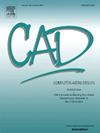转还是扭?局部验证以全局矢量化
IF 3.1
3区 计算机科学
Q2 COMPUTER SCIENCE, SOFTWARE ENGINEERING
引用次数: 0
摘要
本文介绍了一种通过识别转弯和扭转来分析数字曲线的新技术。转弯或扭转,作为一个局部特征,被定义为任何三个连续的运行。twist表示弯曲,turn表示没有弯曲。确定数字曲线中出现的弯曲包括识别穿插在转弯之间的扭曲。我们在正则语言领域内使用像素运行的词理论解释构造了一个明确的语法树。我们演示了这些运行的预图像如何促进离散几何中数字曲线的组合分类,并与语法树分类相关联。这种方法通过遵循某些不变属性的良好定义的分割,实现了数字曲线的有效矢量化。实验结果证明了该方法的优点和有效性。本文章由计算机程序翻译,如有差异,请以英文原文为准。

Turn or twist? Verify locally to vectorize globally
This paper introduces a novel technique for analyzing digital curves by identifying turns and twists. A turn or twist, being a local feature, is well-defined for any three consecutive runs. A twist indicates an inflection, while a turn signifies no inflection. Determining the presence of inflections in a digital curve involves identifying twists interspersed among turns. We construct a definite grammar tree within the domain of regular language using a word-theoretic interpretation of pixel runs. We demonstrate how the pre-images of these runs facilitate a combinatorial classification of digital curves in discrete geometry, correlating with the grammar tree classification. This approach results in efficient vectorization of digital curves through a well-defined segmentation that adheres to certain invariant properties. Experimental results are provided to demonstrate the merit and efficacy of our method.
求助全文
通过发布文献求助,成功后即可免费获取论文全文。
去求助
来源期刊

Computer-Aided Design
工程技术-计算机:软件工程
CiteScore
5.50
自引率
4.70%
发文量
117
审稿时长
4.2 months
期刊介绍:
Computer-Aided Design is a leading international journal that provides academia and industry with key papers on research and developments in the application of computers to design.
Computer-Aided Design invites papers reporting new research, as well as novel or particularly significant applications, within a wide range of topics, spanning all stages of design process from concept creation to manufacture and beyond.
 求助内容:
求助内容: 应助结果提醒方式:
应助结果提醒方式:


